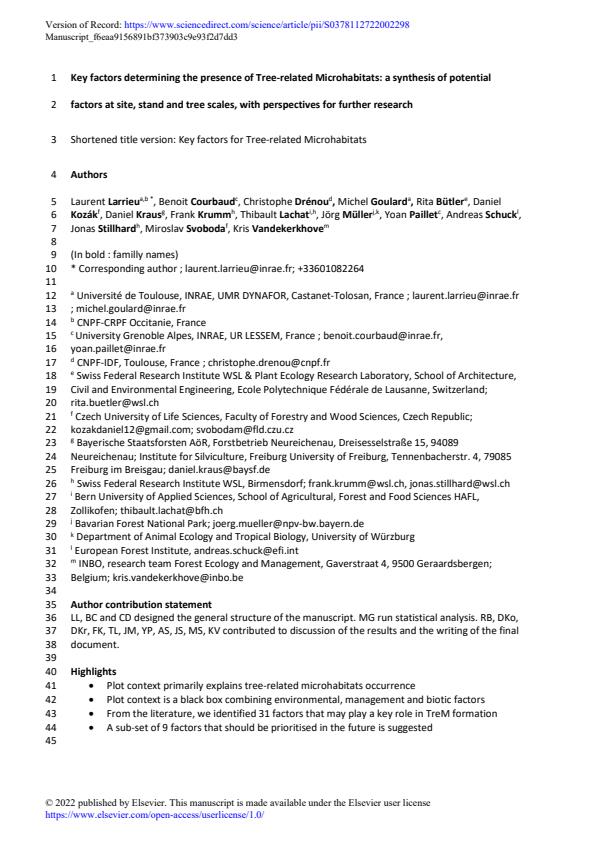Key factors determining the presence of Tree-related Microhabitats: A synthesis of potential factors at site, stand and tree scales, with perspectives for further research
Details
| Volume | 515 |
|---|---|
| Type | A1: Web of Science-artikel |
| Categorie | Onderzoek |
| Tijdschrift | Forest Ecology and Management |
| Issns | 0378-1127 |
| Taal | Engels |
Bibtex
@misc{634970ed-13db-435e-85b7-e99c8597b6c9,
title = "Key factors determining the presence of Tree-related Microhabitats: A synthesis of potential factors at site, stand and tree scales, with perspectives for further research",
abstract = "Tree-related microhabitats (TreMs) have been identified as key features for forest-dwelling taxa and are often employed as measures for biodiversity conservation in integrative forest management. However, managing forests to ensure an uninterrupted resource supply for TreM-dwelling taxa is challenging since TreMs are structures with a limited availability, some of which are triggered by stochastic events or require a long time to develop. At the tree scale, the role of tree species, diameter at breast height (dbh) and status (i.e. living vs standing dead) for favouring TreM occurrence has been quantified and modelled in several studies, since these tree features are routinely recorded in the field. However, TreM occurrence remains difficult to predict, hampering the elaboration of applicable management strategies that consider TreMs. Using an international database encompassing 110,000 trees, we quantified the explanatory power of tree species, dbh, status, time since last harvest and plot context for predicting TreM occurrence at the tree level. Plot context is so far a “black box” that combines local environmental conditions, past and current management legacies, with local biotic features that have high explanatory power for predicting TreM occurrence. Then, based on the literature, we established a set of 21 factors related to site, stand and tree features for which there is a strong assumption that they play a key role in TreM formation. Finally, we identified a sub-set of nine features that should be recorded in the future to provide additional information to enable better prediction of the occurrence of particular TreMs: (i) at plot level: slope, exposure, altitude and presence of cliffs; and (ii) at tree level: bark features, phyllotaxis and compartmentalization capacity of the tree species, plus ontogenic stage and physiological state of the individual tree sampled.",
author = "Laurent Larrieu and Benoit Courbaud and Christophe Drénou and Michel Goulard and Rita Bütler and Daniel Kozák and Daniel Kraus and Frank Krumm and thibault Lachat and Jörg Müller and Yoan Paillet and Andreas Schuck and Jonas Stillhard and Miroslav Svoboda and Kris Vandekerkhove",
year = "2022",
month = jul,
day = "01",
doi = "https://doi.org/10.1016/j.foreco.2022.120235",
language = "Nederlands",
publisher = "Instituut voor Natuur- en Bosonderzoek",
address = "België,
type = "Other"
}
Auteurs
Laurent LarrieuBenoit Courbaud
Christophe Drénou
Michel Goulard
Rita Bütler
Daniel Kozák
Daniel Kraus
Frank Krumm
thibault Lachat
Jörg Müller
Yoan Paillet
Andreas Schuck
Jonas Stillhard
Miroslav Svoboda
Kris Vandekerkhove

